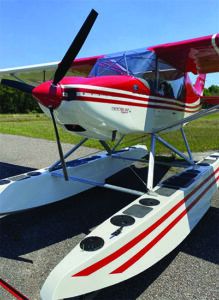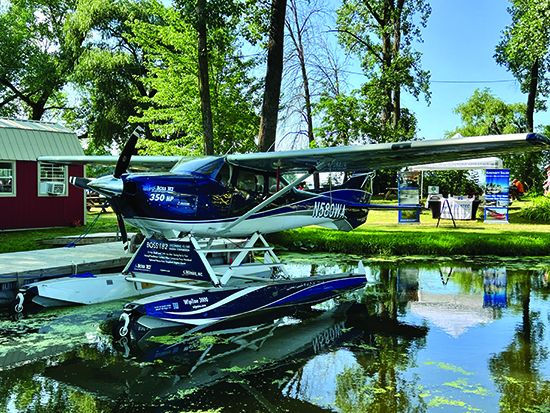Not every seaplane pilot has the means or the skills to run around in that Boss 182 refurbished amphib pictured to the right. There it’s on display at AirVenture last summer at the Lake Winnebago seaplane base—a good place for potential owners to put eyes on a huge variety of seaplane models in action.
With a 350-HP Lycoming engine conversion, Hartzell three-blade composite prop, Wipline 3000 amphibious floats, the latest avionics and custom paint and interior, a Boss amphib typically sells for around $500,000 or more, depending on the year and equipage. It’s a lot of floatplane for the money, with good field support behind it. But for something better suited for lower budgets and less experience on the water, we went shopping to see what’s out there. Several decent entry-level seaplanes caught my eye.
The popular controller.com virtual marketplace listed a 1969 K-model Skyhawk on Wipline 2100 amphibs. The airframe (that has only been in fresh water) had about 5400 hours total time and the engine had just shy of 800 hours since a major overhaul. It’s an example of pretty much wringing out as much performance as possible for getting off the water—160-HP RAM engine conversion, Horton STOL kit and PowerFlow exhaust. For $140,000, it has a decent paint job, it comes with wheels and land propeller and even includes free delivery.

For the same money, there was a nice-looking 2012 Rans S-6LS Coyote S-LSA on Clamar 1400 Kevlar/carbon fiber amphibs, pictured below. The ad said it takes roughly six hours to convert the airplane from wheels to floats. This built-by-Rans Coyote II is powered by a reliable Rotax 912 ULS, which underwent the required five-year major service. It’s a low-time machine with under 200 hours on its clock. It has decent avionics and the sale even includes a tow tractor. In my estimation, this is a versatile choice because when it’s not on amphibs, you can also use it to get some tailwheel experience.
For even more affordable splashing, there was a 1975 Bellanca Scout listed for $92,000. That’s a fair deal because in addition to the Edo model 2000 floats, it comes with 29-inch tundra tires, two propellers (a cruise prop and water prop), plus Aeroski 3000M snow skis. This Scout has VGs, holds 70 gallons of fuel, has ADS-B and new factory wings, plus its fuselage was recovered a few years ago.
Kicking it up a few price points is a 2014 Aviat Husky. With a 180-HP Lycoming engine, the A-1C is a good performer on and around the water. Expect to pay north of $350,000 for these amphib-equipped models that work equally we’ll on wheels and amphibious floats.
For something more complex, consider a 1977 Lake LA-4-200 amphib. It has old avionics, a 1200-hour since new Lycoming engine and was involved in a water landing incident. The asking price is $68,000.
For an ultramodern water machine, used Icon A5 LSA amphibs are hitting the market. There was a 200-hour 2018 A5 on the market for $260,000. This seaplane is powered by a Rotax 912 iS engine and has a BRS parachute and spin-resistant airframe.
But no matter what floatplane you consider, don’t make any move until you get an insurance quote. Our insurance gurus tell us that low-time new seaplane buyers should start with simple machines—perhaps even self-insuring the hull. As one put it: “High-performance amphibs in the hands of beginners isn’t always the best fit and underwriters know it.” —Larry Anglisano


